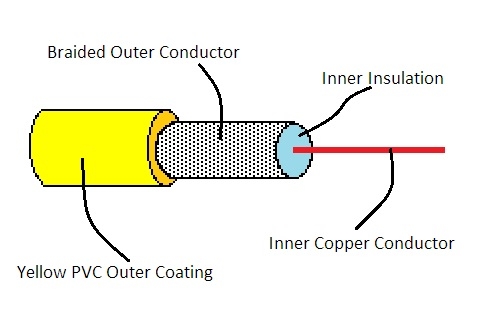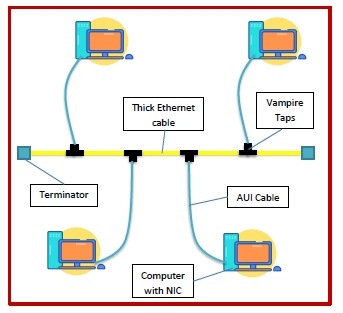
 Data Structure
Data Structure Networking
Networking RDBMS
RDBMS Operating System
Operating System Java
Java MS Excel
MS Excel iOS
iOS HTML
HTML CSS
CSS Android
Android Python
Python C Programming
C Programming C++
C++ C#
C# MongoDB
MongoDB MySQL
MySQL Javascript
Javascript PHP
PHP
- Selected Reading
- UPSC IAS Exams Notes
- Developer's Best Practices
- Questions and Answers
- Effective Resume Writing
- HR Interview Questions
- Computer Glossary
- Who is Who
What is Thick Ethernet?
Thick Ethernet was the first commercially available form of cabling supported by Ethernet. It is technically known as 10-BASE-5. Here, 10 is the maximum throughput, i.e. 10 Mbps, BASE denoted use of baseband transmission, and 5 refers to the maximum segment length of 500 metres (1,600 ft). This type of cabling allows 100 stations to be connected to it by vampire taps. The stations share a single collision domain.

Structure of Cable
The coaxial cable of thick Ethernet is 0.5 inches in diameter and usually has a yellow outer PVC coating. It is a low-loss 50 Ohm cable and is somewhat inflexible. The coaxial cable has a stiff inner copper conductor for transmitting signals. This is covered by an inner insulation. This insulator is encased by a closely woven braided metal outer conductor that acts as a shield against noise. The outer conductor is enclosed by the yellow PVC outer coating. The structure is shown in the following figure −

Network Design
The thick Ethernet is deployed using bus topology. The 10-Base-5 co-axial cable forms the shared bus. Up to 100 stations may be connected to it by vampire taps through AUI (attachment unit interface) cables as shown in the following diagram −


